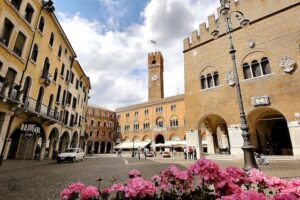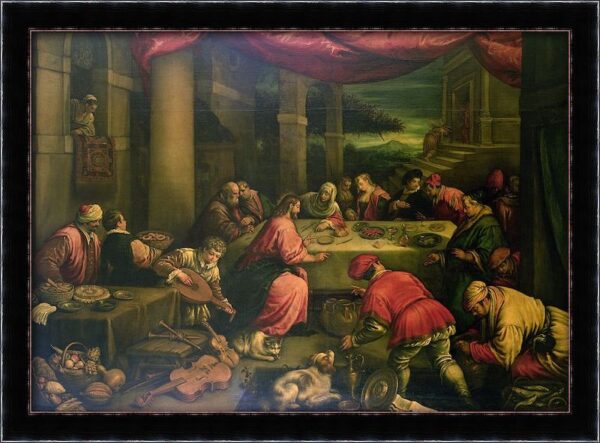TREVISO’S RADICCHIO ROSSO: THE VENETO’S WINTER VEGETABLE

Cooking the radicchio rosso, the Veneto’s winter vegetble

Piazza della Signoria
Treviso isn’t a destination on a traveler’s first itinerary to Italy, but only a half-hour train ride from La Serenissima it’s definitely worth a day-trip especially enjoyable for medievalists, poets, and foodies.
Originally named “Tarvisium, Treviso became a municipium in 89 BC after the Romans added Cisalpine Gaul to their dominions, but, revered in verse by Dante and Petrarch, its heyday and significant monuments date to the Middle Ages. They include its massive city walls; the Romanesque Cathedral dedicated to St. Peter with its cupola later painted by Tiepolo and its altarpiece by Titian; its diocesan museum next door; the Dominican Church of San Nicola with the first artwork depicting eyeglasses, which sadly has been under restoration for over three years and is not visitable; the Church of San Francesco with the tombs of Dante’s oldest son Pietro, who wrote the first commentary of the Divine Comedy, and of Petrarch’s oldest daughter Francesca; and the splendid Piazza dei Signori.

Treviso’s Cathedral
Nearby is the city’s unique and humorous monument: the marble “Boobs Fountain”. One of Treviso’s numerous fountains, she was commissioned in 1559 by Chief Magistrate Alvise Da Ponte after a serious drought. Thereafter, as long as Treviso remained under Venetian Rule (until 1797), at every election of a new Chief Magistrate during the three-day celebration red wine flowed from one of her breasts and white from the other. Then back to water as it is today.

The “Boobs’ Fountain”
Nicknamed “Little Venice”, since the Middle Ages Treviso has also been home to a network of canals once a water link to Venice and to a picturesque fish market on an island in the river Sile. Still a commercial center, today it headquarters Geox shoes and Benetton clothing and accessories, and prides itself as the birthplace of the ubiquitous dessert tiramisù and since September 30, 2004 of the restaurant, bar, and shop “Treviso Tiramisù”.
Another KM-0 gastronomic specialty is radicchio rosso or red chicory, a winter vegetable cultivated in 24 municipalities of the Veneto’s provinces of Padova, Venice, but mainly of Treviso. Often mistakenly considered a lettuce or cabbage, it’s planted in late summer with its harvest starting in October/November and ending at the end of February/beginning of March.
Rich in antioxidants and salts as well as vitamins A, B, C, and K, there are two types of red radicchio with white stripes in Treviso. One is precoce, with wider leaves and a less bitter taste than radicchio tardivo, which can only be harvested after two frosts. It’s considered “The King of Radicchios” and often called “The Red Flower of Winter”. After harvest both types are tied in bunches, immerged in tanks of spring water constantly between 54°-59° Fahrenheit and covered with straw, leaves or shredded corn stalks and a tarp so kept in the dark for 15 days. Thus, not being able to produce chlorophyll, they become blanched.
Radicchio’s origins are uncertain. Supposedly known to Pliny the Elder who swore by its blood purification and sleep-aid properties, it definitely first appeared in northern Italy during the 16th century in the town of Dosson di Casier at the gates of Treviso because birds dropped some seed on the bell tower there which the friars found and cultivated.

Leandro Da Ponte’s “The Marriage at Cana”
This could be true because radicchio’s first artistic representation also dates to this period: Leandro Da Ponte Bassano’s painting Le nozze di Cana (1562-3) today in The Louvre. Its radicchio is in a basket with other fruits and vegetables in its lower lefthand corner. Instead, radicchio’s first certain northern Italian written documentation dates to much later: the second half of the 1800s.
This date coincides with the introduction of blanching in the Veneto by the Belgian park-and-garden designer Francesco Van De Borre, who came to Treviso in 1870 to create an English garden in his Villa Palazzi. The procedure of blanching chicory was already common in Belgium.
Radicchio’s popularity grew thanks to the agronomist from Lombardy Giuseppe Benzi who founded the first fair dedicated to radicchio, held on December 20th, 1900 in the Loggia of Piazza dei Signori. This year the 114th Antica Mostra del Radicchio Rosso di Treviso IGP with cooking shows and tastings is being held nearby from December 8th-10th.
To sample more, head to Toni del Spin for Sopressa con polenta e radicchio or risotto al radicchio or to the birthplace of tiramisù Michelin-starred Le Beccherie for the Spaghetto al Vino Raboso with radicchio. Otherwise, I recommend Ristorante Antico Morer or newly-founded next door to the fish market Med, both also Michelin-starred and for fish, another local specialty.
Radicchio can be eaten raw like a salad, but, if you can’t travel to Treviso now, for many cooked radicchio recipes click on www.radicchioditreviso.it. Be sure to have a bottle of prosecco on hand, the local liquid specialty.
